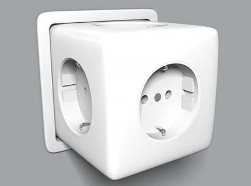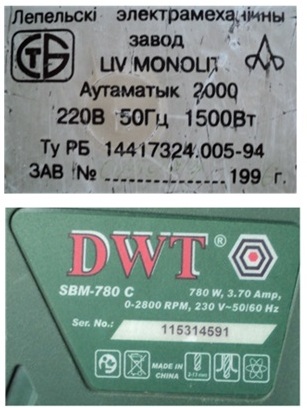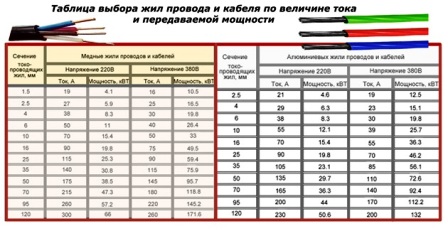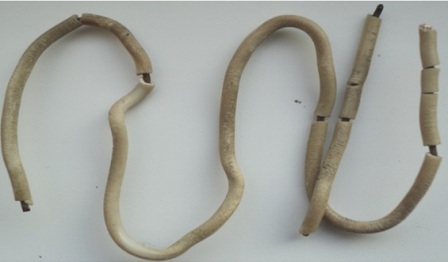Categories: Featured Articles » Sharing experience
Number of views: 25975
Comments on the article: 9
How does the power of household appliances affect electrical wiring
An example from the life of new settlers
 A young family with two children (4.5 years and 5 months) made an exchange and moved to a three-room apartment of a nine-story building built in the 80s from reinforced concrete panels with an elevator.
A young family with two children (4.5 years and 5 months) made an exchange and moved to a three-room apartment of a nine-story building built in the 80s from reinforced concrete panels with an elevator.
The electrical equipment of the apartment is made according to TN-C without a common ground loop and PE conductor. An entrance switchboard is installed in each entrance. From it, power cables diverge along the floor shields. On each floor there are 4 apartments of two blocks; right and left with a common corridor. It mounted apartment shields, which are powered by "aluminum noodles" 2.5 mm2. The same wires made all the wiring in the rooms.
The new owner is a home master who can not only hammer a nail, but also beautifully lay expensive tiles, repair plumbing, connect a washing / dishwasher, find a malfunction in the phone and computer, and troubleshoot software problems. But he is not an electrician, although he repeatedly changed sockets with switches.
When checking the wiring, the owner with a table lamp went through all the outlets and made sure that they were working. And I checked the light bulbs from the switches: they worked. He calmed down and began to decorate the premises, and problems began later.
In the fall, before the heating season, heating was required in the children's room. They included an oil cooler with a power of 2 kW. At that time, a washing machine and a dishwasher, two televisions, a refrigerator with a freezer, a computer, lighting, a cordless telephone and several low-power consumers worked.
The rooms smelled of burnt electrical insulation. Especially strongly he proceeded from the common corridor from the apartment panel. I had to turn off the power from the apartment and understand: the overall picture from the point of view of an electrician looked depressing.
In the corridor, bathroom and living room, a suspended ceiling is made of drywall sheets, blocking access to junction boxes. The bedroom and children's room are covered with expensive decorative wallpaper, and the distribution boxes are not only hidden under them, but also beautifully plastered. Their approximate location had to be clarified with neighbors living on the lower floor. Expensive tiles on the walls and a fixed fabric suspended ceiling completely block access to the wiring in the kitchen.
I had to turn to electricians and technical manuals, to analyze the situation. The aluminum wires of the apartment were mounted under the rated current load, which was created by consumers thirty years ago. In addition, they have already served a decent time:
-
aluminum was subjected to bending, stretching, crimping with screws and its cross-section decreased in the places of deformation;
-
polyvinyl chloride insulation was wiped during drawing through the cavities of reinforced concrete structures and experienced excessive heating from high currents during operation.
The most critical place turned out to be distribution housing panel: where the neutral conductors are assembled. For these purposes, an assembly site of two parts was used. Zero from the floor plate came to the first half, and all other wires were collected to the second half.
Between the sites was a jumper from the same aluminum wire. Through it, like the incoming wire, the whole load of the apartment passed. The metal withstood, and the insulation burned out by more than 2/3 of the length, starting from the first site: different effects contact resistancecreated by screw clamps.
The wire insulation from the floor plate also began to melt, but not so intensely. The fire did not have time to occur - the electricity was turned off on time and the wires were allowed to cool.
Currently in this apartment:
-
defective jumper replaced with copper, capable of withstanding heavy loads;
-
the rules for using electrical appliances were explained to the new owners and their attention was focused on the inadmissibility of the simultaneous inclusion of powerful consumers of electricity.
After a long conversation, the home master:
-
seriously took up the study of electrical engineering and electrical installation rules: plans to replace the wiring with a more powerful one according to the new scheme with a PE conductor and collects money for the upcoming work;
-
He contacted the housing and communal services regarding the transfer of the building to the TN-C-S power supply scheme, but the answer that this work was still planned was not satisfied: he was looking for alternative options for an apartment located on the fourth floor.
Take a look at bgv.electricianexp.com: Diagnostics of the electrical wiring of the apartment before buying
Rules for choosing electrical wiring
To avoid such errors for the safe use of electricity, you need to know the rules for choosing wiring. It is designed for long-term withstanding created current loads that occur when consumers are connected.
The more devices are plugged in, the higher the load on the circuit. In each case, this value varies, but the maximum value is used to select the metal and the cross section of the wire.
In order to determine the maximum power consumption, it is recommended to make a table for all power consumers. Information should be taken from the technical documentation or factory nameplates located on the instrument housing.
Samples of nameplates on the housings of electrical appliances:

As an example, the table may have the following form (although the numerical values may vary).
The list goes on, but it’s impossible to foresee all possible purchases. Therefore, they make a small margin of power, although it should be understood that all of the above devices do not work simultaneously.
The total information is summarized, but taking into account the creation of consumption groups by room. The results are recorded in the prepared table.
Based on the calculations, a hierarchy of the electrical circuit of the apartment is created, which includes not only wires, but taking into account the principle of selectivity, protective devices, control devices, and automation are selected.
To determine the current load in the wire of each group, calculations are performed according to the formulas shown in the figure. For single-phase 220 V and three-phase 380 V circuits, they differ by a value of 1.732.
Calculation of current in a three-phase circuit wire:

Calculation of current in a single-phase circuit wire:

In these formulas, the index “P” indicates the received power of electrical appliances for each group with a voltage of 220 or 380 volts
The simultaneous operation coefficient “KI” approximately takes into account a part of the disconnected devices, and cos φ with such an approximate estimate can be equated to unity: assuming that only the active component of power is consumed. Inductive and capacitive loads, as well as transients during switching on, we neglect.
After determining the currents, you should refer to the tables of the PUE to select the material and the cross section of the conductive core. They take into account operating conditions that additionally create cooling / heating of the metal.
Table of selection of wire and cable cores by current and transmitted power (for increase, click on the figure):
It is likely that the current calculated by the power of consumers does not match the table value. In this case, you should choose the larger of the two options in terms of value and select a section from it.
Read more about choosing the section of wires and cables for home wiring read here: How to choose a cable section. Designer Tips
Installation Errors
When working with electrical wires, individual electricians commit serious violations of existing rules:
-
the metal of the cores is often excessively crimped, scratches and cuts are made with a construction knife, which are difficult to notice with the eye, but over time they lead to a break
-
the insulation is subjected to abrasion during drawing, notching or exposure to solar radiation.
The influence of sunlight on the polyvinyl chloride insulation of electrical wires
Cables and wires are able to work reliably and for a long time: several decades, subject to technology. But the picture below shows the effect of solar radiation on a wire that worked in the open air without any protection for only 5 years. It is impossible to create such conditions for electrical appliances.
Concluding the article, I would like to turn to experienced electricians with a request: supplement the material with your recommendations from practical work. This will help the home foreman who is interested in replacing the wiring in his apartment to do such work better.
Read also on the topic:How to safely operate home electrical wiring with household appliances
See also at bgv.electricianexp.com
:


